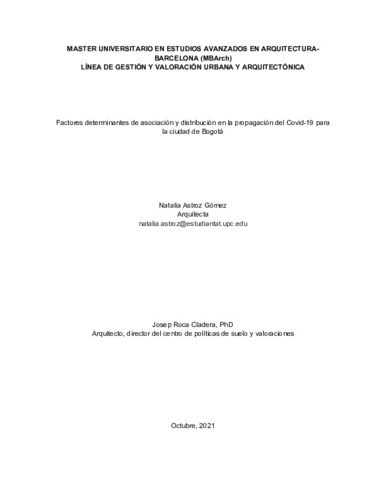Mostra el registre d'ítem simple
Factores determinantes de asociación y distribución en la propagación del Covid-19 para la ciudad de Bogotá
| dc.contributor | Roca Cladera, Josep |
| dc.contributor.author | Astroz Gómez, Natalia |
| dc.contributor.other | Universitat Politècnica de Catalunya. Centre de Política del Sòl i Valoracions |
| dc.coverage.spatial | east=-74.072092; north=4.710988599999999; name=Av Suba #126-95, Bogotá, Colòmbia |
| dc.date.accessioned | 2021-11-29T16:39:45Z |
| dc.date.available | 2021-11-29T16:39:45Z |
| dc.date.issued | 2021-10-28 |
| dc.identifier.uri | http://hdl.handle.net/2117/357243 |
| dc.description | Màster universitari en Estudis Avançats en Arquitectura - MBArch, Gestió Urbana i Valoracions |
| dc.description.abstract | En medio de la coyuntura socio-económica que se esta viviendo mundialmente a raíz de la pandemia del Covid-19 y donde el confinamiento era la única medida apropiada para mitigar la propagación del virus, desde el momento de declararse como pandemia, la cual genera incertidumbre económica por la pausa de actividades, en medio de un país con un índice de pobreza y desigualdad alto, el cual no esta preparado para afrontar una pausa económica y no toda la población vive en condiciones aptas para tener un confinamiento. Además del contexto anterior de salud, la situación social y política del gobierno actual no ha facilitado acciones y propuestas para atender el malestar social declarado a partir de un paro nacional desde el mes de abril del 2021, con manifestaciones en las calles de las ciudades y con los riesgos de contagio y el no seguir las medidas de emergencia en salud que vive el país. Esta investigación propone analizar los indicadores socioeconómicos, urbanísticos y epidemiológicos de las entidades estadísticas de Colombia, DANE, para evidenciar los factores que se asociaron en la propagación de los casos del Covid-19, en la ciudad de Bogotá. Analizando el comportamiento del virus en la ciudad y las localidades que la conforman, y así dar cuenta de cuál fue el comportamiento de los casos del Covid y evidenciar si la hipótesis de la distribución de los casos de Covid-19 en la ciudad de Bogotá se relaciona directamente a los aspectos socioeconómicos y urbanísticos de cada localidad, y cómo cada uno de estos aspectos se ve reflejado en el análisis propuesto. Para lograr el objetivo se estudia la pandemia desde la llegada del primer caso a Colombia, hasta julio del 2021, evidenciando los 3 picos que hubo en el país, se estudiaran los indicadores por medio de estadísticas no paramétricas y modelos de regresión lineal. Los resultados evidenciaron que los casos de Covid estuvieron muy dispersos en la ciudad y que las viviendas sin legalizar y el número de habitantes |
| dc.description.abstract | In the midst of the current socio-economic juncture that is occurring worldwide due to the Covid-19 pandemic, and where lockdown was the only appropriate measure to reduce the virus from spreading since the moment the pandemic was declared, which produces an economic uncertainty due to the pause of activities, in a country with a high poverty and inequality rate, that is not prepared to address an economic pause and where a vast amount of people do not have suitable living conditions for confinement. Aside from the previously described health context, the government ́s current social and political situation has not provided actions and proposals to address the social discomfort that was declared by a national strike on April 2021, with protests that occurred in different cities and with the risks of both infection and not following the measurements of the health emergency that the country is going through. The purpose of this research is to analyze the socioeconomic, urbanistic, and epidemiological indicators of Colombia ́s statistic entities, DANE, to demonstrate the factors that were associated with the increase of Covid-19 cases in the city of Bogota. Analyzing the virus ́s behavior in the city and the localities that make it up, therefore reporting the conduct of Covid-19 cases and demonstrating if the hypothesis of the distribution of these cases in the city of Bogota can be directly related to the socioeconomic, urbanistic, and epidemiological aspects of each location, and how each one of these can be reflected in the analysis that has been proposed. To achieve the objective, the pandemic will be studied from the first case of Covid-19 in Colombia, until July 2021, showing the country ́s three peaks, the indicators by means of non-parametric statistics, and linear regression models will be studied. The results showed that the Covid-19 cases were scattered amongst the city and that the unauthorized housing and the number of inhabitants played a crucial role |
| dc.language.iso | spa |
| dc.publisher | Universitat Politècnica de Catalunya |
| dc.rights | Attribution-NonCommercial-NoDerivs 3.0 Spain |
| dc.rights.uri | http://creativecommons.org/licenses/by-nc-nd/3.0/es/ |
| dc.subject | Àrees temàtiques de la UPC::Urbanisme::Aspectes socials |
| dc.subject.lcsh | City planning -- Social aspects -- Colombia -- Bogotá |
| dc.subject.lcsh | COVID-19 Pandemic, 2020- -- Colombia -- Bogotá |
| dc.subject.other | Covid-19 |
| dc.subject.other | Bogotá |
| dc.subject.other | Desigualdad |
| dc.subject.other | Contagio |
| dc.title | Factores determinantes de asociación y distribución en la propagación del Covid-19 para la ciudad de Bogotá |
| dc.type | Master thesis |
| dc.subject.lemac | Urbanisme -- Aspectes socials -- Colòmbia -- Bogotà |
| dc.subject.lemac | Pandèmia de COVID-19, 2020- -- Colòmbia -- Bogotà |
| dc.identifier.slug | PRISMA-157734 |
| dc.rights.access | Open Access |
| dc.date.updated | 2021-11-24T19:45:19Z |
| dc.audience.educationlevel | Màster |
| dc.audience.mediator | Escola Tècnica Superior d'Arquitectura de Barcelona |
| dc.audience.degree | MÀSTER UNIVERSITARI EN ESTUDIS AVANÇATS EN ARQUITECTURA-BARCELONA (Pla 2015) |
| dc.contributor.committeeMember | Marmolejo Duarte, Carlos Ramiro |
| dc.contributor.committeeMember | Arellano Ramos, Blanca |
| dc.contributor.committeeMember | Biere Arenas, Rolando Mauricio |


